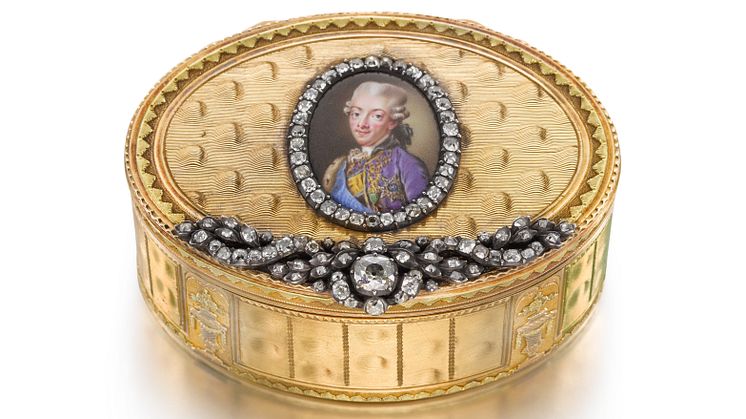
Press release -
Gold box with portrait of Gustav III acquired
Nationalmuseum has acquired a unique gold box bearing a portrait by the court enameller, Johan Georg Henrichsen, of King Gustav III. The box was given by the king as a gift to John Mackenzie, a Scottish officer, when he retired from the Swedish army in 1778. Very few such tokens of royal favour have survived intact, which is what makes this gold box unique.
Jewel-encrusted portraits of the monarch were the most prestigious token of appreciation. The tradition developed at the French court in the 17th century and soon became a model for other European royal houses of the time. These portraits might take the form of a pendant or be mounted in a jewelled setting on the lid of a gold box. Queen Kristina was the first Swedish monarch to adopt this French fashion, which then flourished in the 18th century. Gustav III frequently handed out gold boxes as a sign of royal favour. Contemporary historical sources show that the king took a great personal interest in the design and gave detailed instructions. Sometimes the decoration consisted of his monogram in diamonds, and in other cases his portrait was framed with jewels.
Various specialist craftsmen collaborated to create the boxes. A silversmith would first produce the basic gold box, which would then be decorated by an engraver and adorned with gemstones by a jeweller. A miniaturist then added the portrait, while the case was produced by another specialist, often a bookbinder.
There were practitioners of all these crafts in Gustavian Stockholm, but sometimes boxes were imported from Russia, Saxony or France. The gold box in question was made in Hanau, in the present-day German state of Hessen. It is oval in shape and is decorated with a guilloché (engine-turned) wave and circle pattern within a chased (embossed) border. It is also executed à deux couleurs: in a combination of two different gold alloys to produce colour variations. After the box reached Stockholm, the king’s portrait was set on the lid in a frame of diamonds with trailing vines.
The portrait is the work of Johan Georg Henrichsen (1707–79), the last person in Sweden to hold the position of court enameller, to which he was appointed in 1773. He worked exclusively from originals in pastel or oil created by other artists such as Gustaf Lundberg or, in this case, Lorens Pasch the Younger. The colour palette was often intense, combined with clear use of pointillism. A lesser-known fact is that Henrichsen also produced coats of arms for patents of nobility, painted on parchment using miniature techniques.
The recipient of the gift was a Scottish adventurer: John Mackenzie, Lord Macleod, 4th Earl of Cromartie (1726–89). He had been loyal to Charles Edward Stuart (Bonnie Prince Charlie), the Young Pretender, and was held prisoner after the British army defeated the Jacobites at the battle of Culloden in 1746. Two years later he was pardoned, but the family had its estates confiscated. In 1750 John Mackenzie joined the Swedish army, ending up as colonel of the Björneborg regiment.
“Mackenzie returned to Britain in 1778, having been granted a full amnesty, and had his estates restored. On the occasion of his departure from Sweden, he received this gold box from King Gustav III. It is one of the very few surviving examples from the time and will soon be on display in Nationalmuseum’s Treasury alongside a miniature portrait of Mackenzie,” explained Magnus Olausson, director of collections at Nationalmuseum.
Nationalmuseum receives no state funds with which to acquire design, applied art and artwork; instead the collections are enriched through donations and gifts from private foundations and trusts. The acquisition has been made possible by a generous donation from the Anna and Hjalmar Wicander Foundation.
Inventory number
Gold box à deux couleurs, unknown maker, Hanau. Johan Georg Henrichsen: Portrait of Gustav III, c.1778. Guilloché and chased gold in two shades, diamonds, enamel. NMB 2799.
Media enquiries
Magnus Olausson, director of collections, magnus.olausson@nationalmuseum.se, +46 8 5195 4371
Hanna Tottmar, head of press, press@nationalmuseum.se, +46 8 5195 4400
Categories
Nationalmuseum is Sweden’s museum of art and design. The collections comprise some 700 000 objects, including paintings, sculpture, drawings and graphic art from the 16th century up to the beginning of the 20th century and the collection of applied art and design up to the present day. Nationalmuseum’s responsibility is to preserve and make art accessible and provide knowledge.

